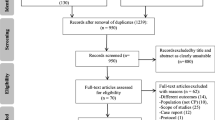摘要
目的
探讨中国脑性瘫痪的康复治疗特点及模式。
方法
分析国内外脑性瘫痪治疗 现状, 结合文献详细阐述国内采用针灸治疗脑瘫的具体方法及其机理研究。
结论
针灸治疗脑瘫有着极大的潜在社会效益和经济效益。 宜开展针灸治疗小儿脑瘫的前瞻性、 多 中心、 随机对照试验, 探索出疗效确切、 可行性强的针灸治疗方案, 建立以针灸为中心 的有中国特色的脑性瘫痪康复体系。
Abstract
Objective
To investigate the therapeutic characteristics and patterns of cerebral palsy rehabilitation in China.
Method
To elaborate the specific acupuncture methods and action mechanism of cerebral palsy in China by combining analysis on the therapeutic situation of cerebral palsy from both home and abroad with research literatures.
Conclusion
Acupuncture has great potential in social and economic benefits in the treatment of cerebral palsy. It is necessary to develop prospective, multi-center and randomly controlled trials on acupuncture treatment of cerebral palsy with exact and feasible therapeutic plans and establish acupuncture-centered cerebral palsy rehabilitation system with Chinese characteristics.
Similar content being viewed by others
Reference
LI Shu-chun. Infantile Cerebral Palsy. Zhengzhou: He’nan Science & Technology Press, 2000: 4.
Duncan B, Barton L, Edmonds D. et al. Parental perceptions of the therapeutic effect from osteopathic manipulation or acupuncture in children with spastic cerebral palsy. Clinical Pediatrics, 2004, 43(4): 349–353.
Stocker K. Acupuncture and Vojta therapy in infantile cerebral palsy—a comparison of the effects, Wiener Medizinische Wochenschrift. 1998, 148(19):434–438.
WANG Qin-yu, YUAN Qin, ZHANG Zhuang-tao, et al. Therapeutic Effect Comparison of Cerebral Palsy with Different Needle-retaining Time of “Jin San Zhen”, Chinese Journal of Clinical Rehabilitation, 2005, 11(9): 156–157.
HE Jing-song. Tang’s Scalp Acupuncture and 82 Infantile Cerebral Palsy Cases. Shanghai Journal of Acupuncture & Moxibustion, 1994, 13(6): 259.
ZHOU Ke-xiu. Scalp Acupuncture and 118 Cerebral Palsy Cases, Journal of Anhui Traditional Chinese Medical College, 1990, 9(4): 48.
LU Li-zhen. Effect of Scalp Acupuncture on Motor Function Rehabilitation of 245 Cerebral Palsy Kids, Chinese Journal of Rehabilitation, 1996, 11(1): 34.
TIAN Shuang-rong. Acupuncture and 42 Cerebral Palsy Cases, Journal of Clinical Acupuncture & Moxibustion, 1999, 15(4): 26.
Author information
Authors and Affiliations
Corresponding author
Rights and permissions
About this article
Cite this article
Wang, Qy. Current situation and characteristics analysis on cerebral palsy rehabilitation in China. J. Acupunct. Tuina. Sci. 5, 332–335 (2007). https://doi.org/10.1007/s11726-007-0332-x
Received:
Issue Date:
DOI: https://doi.org/10.1007/s11726-007-0332-x




